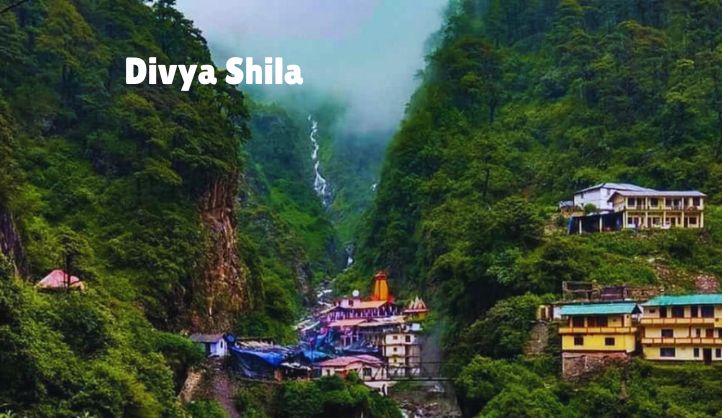Nestled in the majestic Himalayas, Yamunotri is one of the four sacred Char Dhams in Uttarakhand, India. Among its many revered sites, Divya Shila stands out as a spiritual beacon for pilgrims. This sacred rock pillar, also known as the “Divine Stone,” is located near the Yamunotri Temple and holds immense significance in Hindu mythology. Pilgrims offer prayers at Divya Shila before proceeding to the Yamunotri Temple, believing that this ritual purifies them and makes them worthy of the darshan (sacred viewing) of Goddess Yamuna.
Divya Shila is not just a stone; it represents the divine presence and is believed to be a gateway to spiritual enlightenment. The rock is said to be blessed with the divine energy of the goddess Yamuna, making it an essential part of the pilgrimage to Yamunotri. The serene environment, the sound of the flowing Yamuna River, and the towering peaks surrounding the area create an atmosphere of tranquility and devotion.
Historical and Mythological Significance
The significance of Divya Shila is deeply rooted in Hindu mythology. According to legend, Sage Asit Muni, who resided near Yamunotri, worshipped the sacred river Yamuna at this very spot. The rock is considered to have been blessed by the Goddess Yamuna herself, and it is believed that offering prayers here cleanses one’s sins and grants divine blessings.
The ritual of worshipping Divya Shila before entering the Yamunotri Temple has been followed for centuries. Pilgrims believe that this act of reverence ensures that they receive the full blessings of Goddess Yamuna. The stone is also associated with the Vedic rituals and practices that have been passed down through generations, making it an integral part of the Yamunotri pilgrimage.
The Spiritual Journey to Divya Shila
The journey to Divya Shila is as spiritually enriching as the destination itself. Pilgrims embark on a trek through the rugged terrain of the Himalayas, surrounded by lush green forests, cascading waterfalls, and the serene Yamuna River. The trek to Yamunotri is a test of endurance and faith, and Divya Shila marks a significant milestone in this spiritual journey.
The path leading to Divya Shila is adorned with natural beauty, and the air is filled with the chants of pilgrims and the sound of temple bells. As you approach the sacred stone, the atmosphere becomes more charged with spiritual energy. The sight of Divya Shila, with the backdrop of the snow-capped peaks, is awe-inspiring and leaves a lasting impression on the mind and soul.
How to Reach Divya Shila
Reaching Divya Shila and Yamunotri involves a combination of travel modes, including road, rail, and trekking. Here’s a guide on how to reach this sacred destination:
- By Air: The nearest airport to Yamunotri is Jolly Grant Airport in Dehradun, located about 210 km away. Regular flights connect Dehradun with major cities like Delhi, Mumbai, and Bangalore. From the airport, you can hire a taxi or take a bus to reach Hanuman Chatti, the starting point of the trek to Yamunotri.
- By Rail: The nearest railway station to Yamunotri is Dehradun Railway Station, which is well-connected to major cities across India. From Dehradun, you can take a taxi or a bus to reach Hanuman Chatti. Alternatively, you can also reach Rishikesh or Haridwar by train and then continue your journey by road.
- By Road: Yamunotri is accessible by road from major cities like Delhi, Haridwar, Rishikesh, and Dehradun. Buses and taxis are available from these cities to Hanuman Chatti. The road journey takes you through picturesque landscapes, with views of the Ganga and Yamuna rivers, lush forests, and charming villages.
Trekking to Divya Shila
From Hanuman Chatti, you need to trek approximately 13 km to reach Yamunotri and Divya Shila. The trek is moderately challenging, with well-marked paths and facilities like rest stops and refreshment stalls along the way. Ponies and palanquins (dandis) are also available for those who may find the trek difficult.
Best Time to Visit
The ideal time to visit Divya Shila and Yamunotri is between May and October. The weather during these months is pleasant, making the trek more comfortable. The Yamunotri Temple opens for the Char Dham Yatra in May, and the pilgrimage season lasts until Diwali (October/November), after which the temple closes for winter.
Spiritual and Natural Significance
Divya Shila, while spiritually significant, is also surrounded by the breathtaking natural beauty of the Himalayas. The majestic peaks, the flowing Yamuna River, and the lush green valleys create an environment that is both tranquil and awe-inspiring. The natural beauty of the region complements the spiritual experience, making the journey to Divya Shila and Yamunotri a memorable one.
The area is also rich in biodiversity, with various species of flora and fauna native to the Himalayan region. The trek to Yamunotri offers opportunities to spot exotic birds, rare flowers, and even some Himalayan wildlife. The serenity and natural beauty of the region enhance the spiritual experience, making it a perfect destination for those seeking both adventure and inner peace.
Cultural and Festive Celebrations
The region around Yamunotri, including Divya Shila, is steeped in rich cultural traditions. The local communities celebrate various festivals with great enthusiasm, adding to the spiritual ambiance of the place. The most significant festival is the opening of the Yamunotri Temple in May, which is marked by grand celebrations, including prayers, rituals, and cultural performances.
Pilgrims visiting during the festival season can witness these vibrant celebrations and participate in the rituals, making their visit even more spiritually rewarding. The local culture, with its unique customs, traditions, and hospitality, adds to the overall experience of visiting Divya Shila and Yamunotri.
Nearby Places to Explore
Yamunotri Temple
Just a short distance from Divya Shila, the Yamunotri Temple is dedicated to Goddess Yamuna. It is one of the four Char Dham temples and attracts thousands of pilgrims each year. The temple, situated at an altitude of 3,293 meters, is the source of the Yamuna River. The deity is made of black marble, and the temple is a major pilgrimage site.
Surya Kund
A hot water spring located near the Yamunotri Temple, Surya Kund is a significant spot where pilgrims cook rice and potatoes as an offering to the deity. The water in the kund is boiling, and the offerings are later consumed as prasad (holy offering). The kund is named after Surya, the Sun God, who is believed to be the father of Goddess Yamuna.
Janki Chatti
Located 6 km before Yamunotri, Janki Chatti is known for its thermal springs. Pilgrims often take a dip in these hot springs to rejuvenate their bodies before continuing the trek to Yamunotri. The place also serves as a base for pilgrims who are unable to trek the entire distance to Yamunotri.
Kharsali
Kharsali is a beautiful village located 1 km from Janki Chatti and is the winter home of Goddess Yamuna. The village is known for its ancient Shani Dev Temple, dedicated to the planet Saturn. Kharsali offers stunning views of the surrounding mountains and is a perfect spot for a peaceful retreat.
Saptrishi Kund
A trek of about 10 km from Yamunotri leads to Saptrishi Kund, a high-altitude glacial lake. This pristine lake is considered the actual source of the Yamuna River. The trek is challenging and requires a good level of fitness, but the breathtaking views and the serenity of the lake make it worth the effort.
Accommodations and Facilities
For pilgrims visiting Divya Shila and Yamunotri, there are various accommodation options available in nearby towns and villages such as Janki Chatti, Hanuman Chatti, and Kharsali. These range from budget guesthouses to more comfortable hotels and lodges. Most accommodations offer basic amenities like clean rooms, hot water, and simple meals.
During the pilgrimage season, temporary camps and shelters are also set up along the trek route to Yamunotri, providing rest and refreshments to the pilgrims. It is advisable to book accommodations in advance, especially during peak pilgrimage months, to avoid any inconvenience.
FAQs about Divya Shila Yamunotri
What is the significance of Divya Shila in Yamunotri?
Divya Shila is a sacred rock pillar located near the Yamunotri Temple. It is worshipped by pilgrims before entering the temple, as it is believed to purify them and make them worthy of receiving the blessings of Goddess Yamuna.
How can I reach Divya Shila?
Divya Shila can be reached by first traveling to Hanuman Chatti, which is accessible by road from major cities like Dehradun, Rishikesh, and Haridwar. From Hanuman Chatti, you will embark on a 13-kilometer trek to Yamunotri, where Divya Shila is located. The trek is moderately challenging and offers stunning views of the surrounding landscapes.
What is the best time to visit Divya Shila?
The best time to visit Divya Shila is during the pilgrimage season, which runs from May to October. The weather during these months is pleasant, making the trek to Yamunotri more comfortable. The Yamunotri Temple opens in May and closes in October or November, depending on the date of Diwali.
Are there any accommodations available near Divya Shila?
Yes, there are several accommodation options available near Divya Shila, including guesthouses, hotels, and lodges in nearby towns like Janki Chatti, Hanuman Chatti, and Kharsali. During the pilgrimage season, temporary camps and shelters are also set up along the trek route to provide rest and refreshments to pilgrims.
Can I visit Divya Shila in the winter?
Divya Shila and the Yamunotri Temple are not accessible during the winter due to heavy snowfall and harsh weather conditions. The temple and surrounding areas remain closed from November to April. The deity of Goddess Yamuna is moved to the winter home in Kharsali during this period, where pilgrims can offer prayers.
What should I carry for the trek to Divya Shila?
For the trek to Divya Shila, it is recommended to carry warm clothing, comfortable trekking shoes, a raincoat, a walking stick, and basic medical supplies. Since the trek can be physically demanding, carrying water, energy bars, and light snacks is also advisable. Pilgrims should also carry a camera to capture the stunning views along the route.





